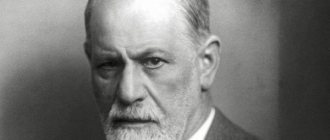The name of the Austrian scientist Sigmund Freud is perhaps one of the most famous in the modern world. He is known even to those who have never opened his works, not to mention small articles. The most commonly heard are the famous Freudian slips; people like to remember his name when they see meaningful oblong objects, such as a cigar or banana. The concept of the unconscious is also often recalled. However, not everyone can accurately explain its essence. In this article we will discuss the psychology of the unconscious, its manifestations, as well as the theory of its follower Jung.
Sigmund Freud
So, this is an Austrian neurologist who became the founder of psychoanalysis. His ideas still cause constant discussions, both in scientific and lay circles. Of course, he became an innovator in the field of psychiatry.
Let's give a short biographical information. Freud was born in 1856 in Freiburg into the family of a textile merchant. Soon after Sigmund's birth, the family had to move to Vienna. From childhood, great hopes were placed on the boy, and he read completely non-children's literature - Kant, Hegel, Shakespeare. In addition, he was very good at learning foreign languages.
After studying at the gymnasium, he entered the medical faculty, but did not feel any desire for this field of science. In fact, the young man chose for himself the lesser evil among the traditional fields of activity for Jews of that time - trade, medicine and law. After graduation, Sigmund intended to continue his academic career, but was forced to give preference to work and soon opened his own office, in which he worked as a neurologist.
In 1885, Freud got an internship with the psychiatrist Charcot, from whom he adopted the technique of hypnosis. In addition, he began to use conversation when working with patients, allowing patients to fully express their emotions. This method will later be called the “free association method”. He allowed the insightful doctor to understand the problems of patients and free them from neuroses.
Gradually, Freud began to publish his books, which first caused rejection and then wide resonance in society: “The Interpretation of Dreams”, “Psychopathology of Everyday Life”, etc. A circle of students formed around him, among whom the famous split occurred in 1910. The main stumbling block was the Freudian idea that the psychoses of the human personality are associated primarily with the suppression of sexual energy.
Sigmund Freud married relatively late and had six children. The famous psychoanalyst died of cancer in 1939.
Psychoanalysis of modern times
Sigmund Freud was convinced that all our actions are dictated by subconscious desires. Particular emphasis was placed on the fact that emerging needs are based on physiology and sexual desires. Modern psychology no longer focuses on this and does not pay too much attention to the statement.
How widespread is psychoanalysis today? In many countries it is quite developed, being quite an ordinary phenomenon. Many modern therapists write books on this topic, which are very popular - that is, it is in demand. Of course, a certain type of society has long resisted the principles of psychoanalysis, not accepting them. This can be said about Germany during the period of National Socialism and the USSR before the Brezhnev stagnation. These examples are the most obvious. Both the fascist and communist regimes opposed Freud's teachings on ideological grounds. The Germans considered these theories “Jewish science that degrades human dignity,” and the Soviet Union considered these theories “the apotheosis of bourgeois individualism.”
Both hidden attempts to oust the teaching from the life of society and obvious repressions against it are known. It is worth recognizing that psychoanalysis also runs counter to many religion-centered and theocratic societies. Although there are cases when it was successfully developed in countries with authoritarian political regimes. The most obvious example is Argentina. According to the assumption of the Argentine psychotherapist A. Benjamin, the reason is that it was the psychologist’s office that usually became the last refuge for oppressed citizens, where freedom of speech was not prohibited.
To summarize, the conclusion suggests itself that freedom is considered the main condition for the successful development of psychoanalysis in society. Let us clarify that in this case, society should share the value of freedom, it should demonstrate the real implementation of freedoms (personality, speech, thought). By the way, for the full development of psychoanalysis, freedom of association is required, which makes it possible for the corresponding community to take shape.
In general, psychoanalysis is quite common in modern society. Various trainings are conducted, therapeutic rooms operate, and relevant literature is published.
Concept of the unconscious
To be fair, it must be said that Freud was far from the first to come up with the idea that a person does not fully control his actions, that there is something in him that forces him to act unconsciously or even irrationally. The idea that the basis of many mental disorders was sexual repression was also not new. Freud's aforementioned teacher, the French psychiatrist Charcot, already expressed this idea.
The merit of the Austrian psychoanalyst is as follows. He was the first to say that a person’s consciousness is only a small part of his personality compared to the huge number of unconscious drives. In order to try to understand and cope with them, the help of an astute psychoanalyst is necessary.
Furthermore, Freud argued that these forces were entirely sexual in nature, which he called “libido.” It becomes active, according to the scientist, from the very first years of human life.
History of psychoanalysis
The history of psychoanalysis dates back to 1880, in the days when the Viennese physician J. Breuer shared with his comrade S. Freud a remarkable story about a patient who was cured of the symptoms of hysteria after a hypnosis session. At the reception, she was able to voice a deeply traumatic event that happened to her. The result was a strong emotional reaction. Catharsis resulted in a significant reduction in symptoms. When the patient emerged from the hypnosis state, she had no memory of her confessions.
Freud decided to apply the technique with his patients - Breuer's results were confirmed. The partners shared their findings in a joint publication, Research on Hysteria, arguing that the symptoms of hysteria are caused by repressed memories of traumatic events. The difficult situation is repressed from consciousness, but continues to influence the patient.
Personal reasons prompted Breuer to withdraw from research and Freud began independent work. He was able to discover that a similar result is achieved not only with hysteria, but also with obsessive states of a sexual nature, often arising in childhood.
The psychoanalyst initially considered the Oedipus complex to be the key cause of neuroses. The symptom begins to form at moments when the child’s unconscious drives threaten to break through the barrier set by repression, which turns out to be unacceptable for other parts of the psyche due to fear of punishment and for moral reasons.
Sigmund Freud's theory
First, let's talk about the structure of personality in the concept of psychoanalysis. So, according to Freud’s theory, personality consists not only of a person’s consciousness, but of several interacting components.
The super-ego (super-ego) is an unconscious part that is acquired even before the appearance of speech in a person. It includes various norms of behavior, taboos and prohibitions formed by culture. This also includes all kinds of family prohibitions, which cause the individual to feel guilty and painfully afraid.
The id (It) is also the unconscious and most primitive part, which includes all kinds of desires and libido. These are extremely ancient, archaic drives that are mostly aggressive and filled with sexuality.
The ego (I) is a conscious component that reacts to what is happening in reality and helps a person adapt to it. It is a kind of intermediary between two other parts, both of which are unconscious. The ego is forced to constantly bifurcate in order to ensure the interaction of the Super-Ego and Id, between the biological desires inherent in everyone and the moral standards that society imposes.
In principle, we can consider two main aspects of the unconscious according to Freud. One of them, the unconscious and non-verbalized part, is an integral element of the human psyche. Thus, the latter is divided into two disproportionate (this will be discussed later) parts. The other side is divided, in turn, into two ego states - Super-Ego and Id.
Priority of the unconscious
According to Freud, the human personality is like an iceberg. On the surface there is a visible, conscious part, the state of the Ego, and under the water there is a block of unconscious drives and desires. And there is always a risk that this iceberg can completely engulf an individual.
This idea was a strong blow to the accepted concept of man. After all, in fact, this meant that he had no power over his own personality, which was subject to the influence of something unconscious and unreflected.
What is this in psychology?
The unconscious is a set of various mental states and processes that are carried out under the influence of certain phenomena of the surrounding reality and the impact of which the individual is not aware of.
The reality reflected by a person is combined with his experiences.
An important feature of this mental process is that it is impossible to control it.
The human unconscious is the subject of study in such fields of knowledge as psychology and psychoanalysis.
The connection between psyche and somatics
Initially, according to Freud, the unconscious was studied within the framework of natural science theories. The psychoanalyst believed that he could find a direct connection between a person’s neurophysiological reactions and the movements of his psyche. The main stages of work at the beginning of the development of his theory were the following: searching for the cause that caused the disease (most often it is some kind of trauma, often it occurs in childhood), research into the consequences (that is, disruptions in the functioning of the psyche) and treatment (it is necessary to provide the patient with the possibility of mental release ). Gradually, Freud began to use word therapy, and this already went far beyond the scope of the natural science concept.
Modern look
Modern cognitive science has made great progress. The main subject of her research is consciousness, but without studying the unconscious, the study of consciousness is not possible. It should be noted that this issue is of interdisciplinary significance and is studied from the perspective of neurophysiology, artificial intelligence research, linguistics, anthropology, and psychology. The study of the unconscious made it possible to describe the mechanism and origin of such processes as:
- Perception
- Memory
- Creation
Russian scientists studying the problems of the unconscious: N.T. Abramova, N.S. Avtonomova, D.I. Dubrovsky, V.A. Lecturer's Creativity in the context of the unconscious was studied by I.A. Beskovaya, I.A. Gerasimova. In foreign studies, the problems of the unconscious are represented by the philosophical works of D. Dennett, D. Fodor, D. Searle. And we undoubtedly owe a lot in modern science and art to this discovery. A discovery that served as the basis for a new understanding of human thinking and existence.
The essence of the unconscious
It is important to note that the unconscious, according to Freud, is a product of repression. What is exposed to this effect and how, here the opinions of different researchers may differ. But the psychoanalyst himself believed that repression can occur exclusively in the direction of the Super-Ego. It is a kind of representative of society in a person.
In the course of childhood development, various unwanted drives gradually move into the region of the superego, and it is impossible to extract them from there except by the method of free association or hypnosis. Undesirable thoughts and inclinations can be those that contradict the norms accepted in society, its morality, as well as those inclinations that worry us excessively.
In this case, the Super-Ego is a stronger subject that displaces certain weak psychological forces, for example, childhood impressions that are unacceptable to society.
Kinds
The classification is as follows:
- Congenital . As the name suggests, we have it initially, from birth. It is divided into individual (attraction, instincts) and collective. Below we will look at the archetypes of the collective unconscious, who discovered them and what their essence is.
- Social . This includes attitudes, values and beliefs that appear and are formed in us during our upbringing, under the influence of others, primarily family.
- Repressed . It is formed under the influence of our censorship, when feelings and desires unacceptable to a person are transferred from consciousness to this area.
- Preconscious . This includes feelings and thoughts that were previously conscious, but have now lost their relevance and have been transferred to this sphere.
How to independently develop emotional intelligence? Read about it here.
Foundation concept
Conflicts arise between the conscious and unconscious parts of a person, resulting in neuroses and mental disorders that interfere with normal human life. This became the main idea of Freud's concept of the unconscious. Painful and shameful experiences are repressed into the superego and manifest themselves in the form of unpleasant symptoms somewhere on the border between somatic and mental manifestations.
Accordingly, in order to balance these conflicts, it is necessary to establish a balance between the Ego and the Super-Ego, which is what psychoanalysts do. During the patient's long story about his thoughts and feelings, with the help of a specialist, he gradually comes to the true cause of his neurotic behavior. “According to grandfather Freud,” such a reason, of course, is suppressed sexual desires. According to modern psychoanalysts, there can be a large number of reasons, and for each person they are individual.
How does the unconscious manifest itself?
According to Freud, unconscious aspirations are hidden from the conscious part of the human personality. However, they can manifest themselves in reality in various ways.
So, this can manifest itself in the form of slips of the tongue, accidental slips, unexpected actions of which a person is not aware. In fact, this is the idea behind the phrase “Freudian slip.” In addition, the Id and Super-Ego are reflected in the dreams that haunt a person. Psychoanalysts pay a lot of attention to dreams. They are considered messengers of the unconscious, filled with important symbolism.
Thus, the forms of manifestation of the unconscious in a person’s everyday life are varied. But in order to understand whether the hidden part of our personality is really making itself felt, it is still worth contacting a specialist. Unfortunately, from his own point of view, a person cannot always judge his own personality. However, that’s why it’s unconscious.
Mistakes of everyday life
Examples are slips of the tongue, slips of the tongue, forgetting intentions, unexplained loss of things. All these manifestations of B. are material for analyzing the causes of symptoms.
Causes. Typically these are unresolved problems or repressed desires.
It’s rare that slips of the tongue can be called anything other than “slips of the tongue.” These are reservations in their purest form: I wanted to say “open”, I said “close”. Most slips of the tongue are impaired speech. One component of the slip is what he wanted to say consciously, and the other is what he said unconsciously. Example: it said, “I’ll give it up?”, I wanted to say, “I’ll give it to myself?”
Here is an example from Freud’s own life: an exquisite and expensive pencil was lying on his desk. You need to look for lost things (according to F.) in the following way: “Who gave the pencil? What happened to the donor recently?
So, Freud recalled that the other day he had a quarrel with his wife. And before I had time to remember this, the pencil was already lying in its original place, in front of the scientist’s nose.”
Now you have a clear understanding of the problem of the unconscious in psychoanalysis. It's time to go deeper.
Eros
Eros is a sexual instinct, it is a manifestation of libido. A person, not being in the herd, cannot fully realize all his sexual aspirations. He unwittingly has to suppress them, limiting himself. In a favorable situation, sexual energy will be directed towards creation, creativity, science or political activity.
In other words, in any direction that requires a powerful investment of strength and manifestation of oneself. Sigmund Freud called this displacement of the sexual instinct into another sphere the term “sublimation.”
Carl Jung and his ideas
One of Sigmund Freud's most beloved students was Carl Gustav Jung. He subsequently disappointed his teacher.
Jung and Freud were similar in their ideas in many ways. However, Sigmund paid attention to a specific personality, as if split into three main components common to every person. Thus, for Freud, the unconscious was contained within the individual.
Jung identified another concept - the “collective unconscious”. According to his ideas, it is common to all humanity and unites a variety of people. The collective unconscious in a culture manifests itself in the form of archetypes, certain common symbols that are significant for every person, no matter what culture he belongs to. These images - Anima, Animus, Mother, Shadow, etc. - will evoke a response in his soul. Accordingly, such archetypes manifest themselves in one way or another in every culture.
However, the collective unconscious should not be understood as something supra-individual. This is a complex scheme, but according to Jungian psychology, through it a person goes through a process of individualization, in fact it is a process of becoming a personality in the full sense of the word. Thus, this is both a deeply individual principle and common to all people.
Criticism of the scientific community
Many eminent scientists of the 20th century expressed their doubts about Freud's ideas. Let us highlight the main ones:
| Scientist | Criticism |
| Fritz Perls | The creator of Gestalt therapy, in his author’s works, seems to be conducting a constant critical dialogue with Freud, challenging all sorts of aspects of psychoanalysis [1]. |
| Erich Fromm | He accused him of being too “bourgeois” and adapting classical psychoanalysis to the needs of the time [2]. |
| Albert Ellis | Having succumbed to the stronger influence of the works of Karen Horney and Erich Fromm, he leaves the ranks of ardent supporters of the theory of psychoanalysis and refutes many of its fundamental principles [3]. |
| Karl Kraus | The literary critic reproached F. for creating almost a new secular religion, where the main figure of worship is the psychoanalyst himself. |
| Karl Popper | Scientist known for creating the falsifiability criterion. While studying F.’s works, he doubted the scientific nature of psychoanalysis and called the theory untrustworthy [4]. |
| Alfred Adler | One of the accomplices and potential successors of Freud’s “circle” repeatedly subjected Freud’s ideas to devastating criticism, which was the reason for their quarrel. |
| Carl Jung | The departure of Carl Jung himself from F.'s circle of associates turned out to be a stab in the back. The split occurred due to Jung’s passion for occult practices and rejection of F.’s idea of the supremacy of the sexual component in the human psyche [5]. |
| Hans Jurgen Eysenck | One of the leaders of the biological direction in psychology, the creator of the factor theory of personality, the author of a popular intelligence test, wrote in his book: “Instead of experimentally verified conclusions from clearly formulated hypotheses, we find only anecdotal evidence collected rather randomly from individual case histories.” [13]. |
The reason for this is most likely not only the shocking ideas of the psychologist, which shocked the scientific community, but also a deep analysis of the work of the “discoverer”. Moreover, no one had dared to speak so openly about such intimate aspects of a person’s life before.
Sex is the end in itself of all things! Z. Freud
Results
So, according to Freud, the unconscious is a mental phenomenon universal for every person, which largely determines his behavior. It is also a source of mental disorders.
The Austrian psychiatrist defined the concepts and types of the unconscious - the Id and the Super-Ego. The second has a much stronger impact on a specific person, since it is his individual unconscious.
Subsequently, Freud's students developed the concept of personality structure. It became clear that there are much more types of the unconscious than the discoverer of this concept assumed. Post-Freudianism and neo-Freudianism acquired a large number of followers - Jung, Adler, Fromm, etc.
Freud's theory is still discussed and criticized today. But it is impossible to deny that it had a large-scale influence on the development of science and philosophy of the 20th and 21st centuries, and in particular on the study of the psychology of the unconscious.










